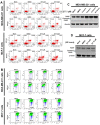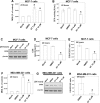Danshen Improves Survival of Patients With Breast Cancer and Dihydroisotanshinone I Induces Ferroptosis and Apoptosis of Breast Cancer Cells
- PMID: 31736748
- PMCID: PMC6836808
- DOI: 10.3389/fphar.2019.01226
Danshen Improves Survival of Patients With Breast Cancer and Dihydroisotanshinone I Induces Ferroptosis and Apoptosis of Breast Cancer Cells
Abstract
Danshen (salvia miltiorrhiza Bunge) is widely used in traditional Chinese medicine. However, it is definite clinical effort and mechanism on breast cancer is unclear. In our study, we used the real-world database to investigate in vivo protective effort of danshen in the breast cancer patients through using population-based data from the Taiwan National Health Insurance Research Database (NHIRD). In vitro, human breast cancer cells (MCF-7 cells and MDA-MB-231 cells) were used to investigate the effect and the underlying mechanism through XTT assay, flow cytometry, glutathione peroxidase (GPX) activity assay, GSH (reduced glutathione)/GSSG (oxidized glutathione), malondialdehyde (MDA), and western blot analysis. The in vivo effect was investigated through a xenograft nude mouse model. We found that dihydroisotanshinone I (DT), a pure compound present in danshen, can inhibit the growth of breast carcinoma cells, including MCF-7 cells and MDA-MB-231 cells. Moreover, DT induced apoptosis and ferroptosis in these breast cancer cells. DT also repressed the protein expression of GPX4 (Glutathione peroxidase 4). For in vivo study, DT treatment also significantly inhibited the final tumor volume without adverse effects in a xenograft nude mouse model. In conclusion, danshen has protective efforts in breast cancer patients, which could be attributed to DT through inducing apoptosis and ferroptosis of breast cancer cells.
Keywords: GPX4; National Health Insurance Research Database; breast carcinoma; danshen; dihydroisotanshinone I; ferroptosis.
Copyright © 2019 Lin, Shen, Wu, Tsai, Yang, Lin, Kuan, Lu, Chang, Tsai, Hsu, Yeh, Yang, Lee, Shu, Cheng, Liu, Wu, Wu and Chang.
Figures






References
-
- De Mello Ramirez Medina J., De Araujo Trugilho I., Mendes G. N. B., Silva J. G., Da Silva Paiva M. A., De Aguiar S. S., et al. (2019). Advanced Clinical Stage at Diagnosis of Breast Cancer Is Associated with Poorer Health-Related Quality of Life: A Cross-Sectional Study. Eur. J. Breast Health 15, 26–31. 10.5152/ejbh.2018.4297 - DOI - PMC - PubMed
LinkOut - more resources
Full Text Sources
Miscellaneous

